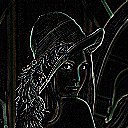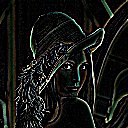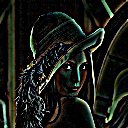 Fred's ImageMagick Scripts
Fred's ImageMagick Scripts
Copyright © Fred Weinhaus My scripts are available free of charge for non-commercial (non-profit) use, ONLY. For use of my scripts in commercial (for-profit) environments or non-free applications, please contact me (Fred Weinhaus) for licensing arrangements. My email address is fmw at alink dot net. If you: 1) redistribute, 2) incorporate any of these scripts into other free applications or 3) reprogram them in another scripting language, then you must contact me for permission, especially if the result might be used in a commercial or for-profit environment. Usage, whether stated or not in the script, is restricted to the above licensing arrangements. It is also subject, in a subordinate manner, to the ImageMagick license, which can be found at: http://www.imagemagick.org/script/license.php Please read the Pointers For Use on my home page to properly install and customize my scripts. |
|
Generates high pass or low pass filtered images based upon a gaussian shaped convolution. |
file is missing or empty
|
USAGE: gaussian [-w width] [-k kind] [-m mix] infile outfile
-w ...... width .......... width for Gaussian blur filter; PURPOSE: To generate high pass or low pass filtered images based upon a Gaussian shaped convolution. DESCRIPTION: GAUSSIAN generates an output image which is a user defined mix or blend of the original image and a Gaussian blurred version of the image. The basic blended low pass filtering formula is F = (1-m)*I + m*L, where I is the original image, L is the Gaussian low pass filtered image and m = mix/100. When m=0, we get only the original image and when m=1, we get only the low pass Gaussian filtered image. For intermediate value of m, we get a blend of the image and the Gaussian low pass filtered image. For high pass filtering, we form the high pass filter by subtracting the low pass filter from the original Thus in the formula above L is replaced by H=(I-L), and as the high pass image is primarily black we simply add the percentage of the high pass image to the original image so that F = I + m*H, which also can be expressed as F = (1+m)*I - m*L. For the edge image, we simply output the high pass filtered image so tht F=H. ARGUMENTS: -w width ... WIDTH is the (half) width for the Gaussian blurring (low pass) convolution filter. This corresponds to sigma for the -blur IM function with radius set to 0 so that it is determined automatically. Width is a positive floating point value. Default=1. See the function -blur in the IM documentation. -k kind ... KIND is the kind of filter, either a high pass, low pass filter or edge image are allowed. Thus kind=high, low or edge. The default=high. A low pass filter will cause blurring. A high pass filtered image will produce either sharpening and the edge option will extract edges. See below. -m mix ... MIX is the percentage mixing factor to use to blend the filtered result with the original image. For kind=low, a value of mix=0, results in the original image and a value of mix=100 results in a pure low pass filtered image. For low pass filtering, a larger value for mix will produce more blurring. For kind=high, the mix percentage of the high pass filtered image will be added to the original image. A larger value for mix will sharpen or highlight the edges more. Fr kind=edge, the mix value is not relevant or is ignored. The default is mix=20. CAVEAT: No guarantee that this script will work on all platforms, nor that trapping of inconsistent parameters is complete and foolproof. Use At Your Own Risk. |
|
Low Pass Filtering | |||
|
Original Image |
Arguments: |
Arguments: |
Arguments: |

|

|

|

|
|
High Pass Filtering |
|||
|
Original Image |
Arguments: |
Arguments: |
Arguments: |

|

|

|

|
|
Edge Extraction |
|||
|
Original Image |
Arguments: |
Arguments: |
Arguments: |

|

|

|

|
|
What the script does is as follows:
This is equivalent to the following IM commands for
|